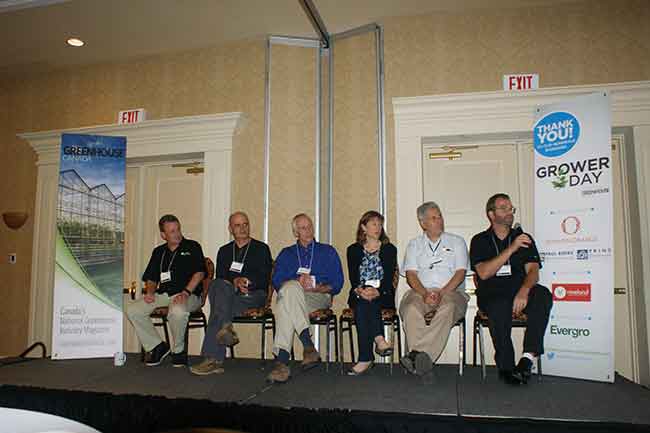
Features
Biocontrols
Inputs
Updating Naturally Effective Tools That Keep Pests at Bay
Microbial products are generally compatible with other beneficials and also with many pesticides.
September 16, 2015 By Brandi Cowen and Dave Harrison
 The panel discussion included, left to right, Dr. Matthew Krause, Albert Grimm, Dr. Michael Brownbridge, Dr. Anissa Poleatewich, Norm Hansen and James Kowalski.
The panel discussion included, left to right, Dr. Matthew Krause, Albert Grimm, Dr. Michael Brownbridge, Dr. Anissa Poleatewich, Norm Hansen and James Kowalski. October 2015 – Biopesticides are an increasingly popular resource for greenhouse growers, both for flower and vegetable crops.
And if you’re not already using them, you’re missing out on some very important tools.
That was the consensus of speakers – and attendees – at this year’s Greenhouse Canada Grower Day, held in St. Catharines.
The topic was timely, reflected by the turnout of growers for the day, and in particular by pre-registrations which were much higher than usual for Grower Day events.
There were several key take-home messages.
- Do your homework and test selected products. “Don’t immediately jump in with both feet,” said one speaker. “Take your time with it.”
- These are primarily preventive controls, and generally work best with low to moderate disease pressures.
- They don’t offer 100 per cent protection, and should be part of an overall IPM program.
- Read the label, talk to suppliers and growers, and consult with specialists.
- They’re compatible with other natural enemies and many chemical controls.
- They’re highly effective when used correctly.
AN IDEAL FIT WITHIN IPM
Dr. Michael Brownbridge is research director in horticultural systems at the Vineland Research and Innovation Centre. Research activities of this group include development of biocontrol-based IPM systems for greenhouse ornamentals and vegetables.
During his talk, Brownbridge focused on the use of microbial biopesticides in pest management. They are generally compatible with other beneficials (predators and parasitoids) and also with many pesticides, he noted, which makes them an ideal fit for IPM programs.
Their short re-entry intervals after application makes them easy to work with on a day-to-day basis, and they can be used right up to the day of harvest. “They’re also very easy to use,” said Brownbridge. “They don’t require specialized equipment.”
Timing is important, he said, because different insect stages are more susceptible than others.
They also work best when used in a preventive manner.
It’s important the material is placed where it will reach the target, and at sufficient concentration to be effective. “The spores must come into contact with the pest, either at the time of spraying or when picked up when the insect moves over or through the treated foliage or substrate.”
Repeat applications are needed to combat pests where there are overlapping life stages, “and also given the fact you will never reach 100 per cent of the population at any time.”
However, for foliar applications, a fine mist spray is better in order to coat the leaves while not wetting them. There are a number of research trials underway with low-volume sprayers.
Research at Vineland has shown that biopesticide dips are an effective strategy in controlling whiteflies on poinsettia cuttings.
It’s also been found that soil microbials induce changes that enhance plant growth and promote disease resistance.
Brownbridge emphasized the importance of only using registered products that have been thoroughly tested and proven to be effective.
LONG-TIME USAGE
Albert Grimm is head grower at Jeffery’s Greenhouses in St. Catharines, a major Ontario flower grower.
They’ve been using biopesticides for about a dozen years.
When doing something that’s primarily preventive, it’s very difficult to see whether it’s working or not, he said. With a chemical treatment, growers can see what it has killed. “You know it has worked.”
And as with any biocontrol, you have to have faith it was developed, packed, shipped and stored correctly.
“Efficacy is very difficult to assess,” said Grimm. “They do something, but how much have they done?”
It’s important to check expiry dates, to be sure you have something reasonably fresh. However, these dates can be meaningless if there is improper transport or storage.
Being living organisms, they are sensitive to chlorine, a challenge to growers who use municipal water. In those cases, growers should fill their sprayers with water early in the day and well before mixing so it will gas off.
Microbials are often also sensitive to UV light, so it’s best to spray at the end of the day and not in direct sunlight.
DO YOUR HOMEWORK
Norm Hansen is the director of research and development at Erieview Farms, a leading organic greenhouse vegetable producer in the Leamington area.
“As an organic grower, we don’t have backup chemical treatments,” said Hansen. “We can’t rotate in any synthetics. You have to do your homework to be sure these products will work.”
The PMRA has posted a list of microbials to its website. This is an important resource for growers who want to be aware of everything that’s available and the various active ingredients. It’s even more important when using microbials because they’re alive and there has to be a certain set of conditions in place for them to work effectively.
Growers must do their homework.
“Do your own confirmation research,” Hansen said. “Make sure you test them to be sure they work under your conditions.”
And be patient. It’s not a case of applying them once or twice and seeing an effect.
Don’t spray your whole farm. Work on a smaller area for your trialling so you can compare results with a control area. If don’t have a control, said Hansen, you won’t know if the problem wouldn’t have resolved itself on its own.
For rates, always consult the label. The time of day is important, and Hansen has found early morning, late evening, or late at night work best for him.
Microbials are living organisms, so humidity, temperature, the lighting and other environmental factors can make a difference. “If you change your nutrition system, it might have an impact.”
Employees appreciate that you’re not using synthetic pesticides, and plants are definitely not stressed by them.
“They’re definitely cost-effective in the long run.”
GREAT PRODUCT POTENTIAL
James Kowalski is a technical specialist for Monsanto’s BioAg Diversified
Specialty Markets division. He has worked with biocontrols since 2002 after joining his family’s company, Natural Industries.
He said there are a number of reasons microbial use in horticulture is gaining in popularity. “It’s my opinion that industry movement toward more sustainable growing practice and lessening any environmental impact are key.”
Equally important, he added, is that the new modes of action they bring have yet to show mutational resistance issues and also help the effectiveness of chemicals through resistance management.
Microbials hold great potential. “There is so much to be discovered and improved with microbes in horticulture. It is truly in its infancy and the next decade and beyond will yield amazing advancements.”
So what is his advice to help growers get started with these new products, or to take a current program to the next level?
“The best way to get the most effectiveness out of your new microbial products is to contact the manufacturer rep for your area,” said Kowalski. “They can provide insight on how they function and recommend ideal conditions for application.”
If a grower is going to run into problems with microbial products, it may be due to their water source.
“THIS IS TRUE IPM”
Dr. Matthew Krause is the product development manager for BioWorks. Most biopesticides, he said, act preventively rather than curatively.
They are effective in dealing with low to moderate disease pressures, and frequently provide other beneficial effects on plant health.
“This is true IPM,” he said. It looks at the entire production chain from start to finish and helps growers “be proactive.”
Biopesticides are compatible with many chemical controls and other biopesticides. Good IPM also includes good exclusion efforts, sanitation programs and environmental controls, he noted.
But when a problem does develop, accurate diagnostics are key. When in doubt, send samples out to be tested. The proper product can then be selected once you know exactly what you’re dealing with.
Follow the label instructions for the correct rates, how best to use it safely, and how the product should be stored. “Good distribution and proper concentrations are critical … You have to know when and how often to apply.”
Don’t immediately jump in with both feet, he cautioned.
“Take time to evaluate the product on a smaller scale.” Set up a small comparison trial so you can see the difference the biopesticides are making.
With the trials, document everything. “Record what you and your staff see and experience, and take photos so you can come back later to see the good, the bad and the surprises.”
DERIVED FROM NATURAL MATERIALS
Dr. Anissa Poleatewich, a plant pathology research scientist within Vineland Research and Innovation Centre’s horticultural production systems department, provided an overview of how biological controls can be used in greenhouse production.
“Basically you’re using beneficial organisms to suppress pest organisms,” Poleatewich explained.
Biocontrols can be used to suppress many types of pest organisms, including insects, plant pathogens and weeds; Poleatewich’s talk focused primarily on how biocontrols can be used to protect against pathogens.
These biocontrols act to reduce disease in three ways: by making the environment less favourable to a plant pathogen; by parasitizing or inhibiting the pathogen’s growth; and by activating the plant’s natural defenses against the pathogen.
“Oftentimes more than one of these effects is happening at the same time; it’s usually not one or the other,” Poleatewich said.
“Sometimes it’s hard to take a biocontrol product and pinpoint exactly what mechanism is working because there are multiple modes of action.”
Biopesticides are derived from natural materials, including animals, plants, bacteria and certain minerals. These may include micro-organisms such as RootShield and Met52, naturally occurring substances such as MilStop and Regalia, as well as substances naturally produced by plants.
“Biopesticides suppress disease with unique modes of action. They act preventatively, before disease starts to harm plants,” Poleatewich said. “They’re most effective at low to moderate disease pressure.”
Beyond proactively suppressing disease, she added, they can also promote rooting and plant growth, aid plants in overcoming environmental stresses (including water, temperature and nutrient stress), and enhance the availability of nutrients.
“What they do not do is offer 100 per cent protection,” Poleatewich added. “This is why the best benefits can be realized when they’re integrated in an IPM program.”
Benefits of using biopesticides include resistance management, and short re-entry and pre-harvest intervals. Poleatewich also noted that most biopesticides are exempt from maximum residue limits (MRLs), have positive perceived impacts on worker safety and consumer opinion, and align with market trends and consumer demand for sustainability. And all this while delivering minimal impact on beneficial organisms.
However, because biopesticides are living organisms, there can be a bit of a learning curve before growers start to realize their full benefits.
Poleatewich said that proper use is key: know your crop and your pathogen. She also highlighted the importance of using registered products and seeking
input from extension specialists and product technical support. And, of course, growers should apply biopesticides according to the label only after checking for compatibility with products already in use on a crop.
“The goal in using biopesticides is to manage disease, to reduce the harmful effects caused by a disease,” Poleatewich said. “It’s a continual process and you need to know the biology of the pathogen you’re trying to control, as well as the biology of the biopesticide.”
INTERVIEWS WITH GROWER DAY SPEAKERS HAVE BEEN POSTED TO OUR VIDEO ARCHIVES SECTION AT GREENHOUSECANADA.COM.
Print this page


